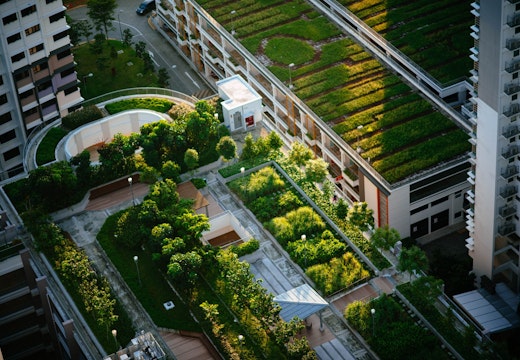Madrid named hottest place to work among major world cities
The Spanish capital takes the top spot with the most extreme urban island heat effect according to a new survey from Arup. Digital modelling is proposing ways to bring city-centre temperatures down
Which is the hottest major city in the world in which to work? As Spanish office workers swelter through another heatwave, Madrid can reasonably claim this mantle. Its city centre has the most extreme urban heat island ‘hot spot’ of six major cities around the world, with temperatures 8.5°C hotter than rural surroundings, according to new research from sustainable development consultancy Arup.
Arup’s ‘Urban Heat Snapshot’ is designed to help cities understand how heat is impacting them from one neighbourhood to another, and what can be done to reduce temperatures. The report’s authors highlight how city design is driving up urban temperatures – with nature often pushed out, streets asphalted, and tall buildings made of steel and glass.
Extreme hot spots
Using AI and satellite images from space, the analysis mapped the most extreme hot spots in a diverse range of cities: Cairo, London, Los Angeles, Madrid, Mumbai and New York. Arup used its digital analytics tool, UHeat, to understand the difference in air temperatures experienced from neighbourhood to neighbourhood, on the hottest day in each city in 2022.
Next to Madrid, the survey showed Mumbai had the second most severe hot spot at 7°C, while New York and London both experienced hot spots of 4.5°C.
UHeat draws on an advanced climate model by the University of Reading in the UK and demonstrates how advanced digital tools can bring academic models to real-word scenarios to find the causes of the urban heat island effect. It can then, says Arup, model solutions to show how nature and other interventions can help cities reduce the impact of hot spots.
In the majority of cities, the hottest spots had less than 6 per cent vegetation cover, while the coolest spots in most cities had over 70 per cent and were found almost entirely in parks, away from residential and commercial areas. This contributed to massive temperature swings within cities, with Madrid’s built up downtown experiencing heat almost 8°C hotter than El Retiro Park, a short distance away.
Key recommendations
The authors are urging city leaders, urban designers and planners to better understand how their designs can mitigate hot spots, particularly for the most vulnerable communities.
Dima Zogheib, Nature Positive design lead at Arup, explains: ‘We’ve inadvertently designed many of our cities to be hot. We’ve pushed out nature – concreted our streets, built high in steel and glass. And we’ve largely confined our green spaces to grand parks, away from where most people live. Ponds, lakes, trees, grasses, soils and other surfaces that allow water to permeate into the ground have to be seen as vital infrastructure, essential to helping us adapt to climate change.’
The report recommends cities focus on:
- Increasing tree canopy cover – trees have been proven to lower temperatures in cities and reduce heat-related mortality.
- Creating more permeable surfaces – permeable surfaces, such as bare or planted soil, tend to absorb less heat compared with impermeable surfaces such as concrete or asphalt
- Using every space possible – more than half of the space in cities (including roofs and streets) is open space, providing a large canvas for building resilience, with potential interventions including greening building facades and roofs or using white paint to change the reflectiveness of surfaces and reduce the amount of heat absorbed from the sun.
- Establishing cool islands – with cities set for heatwave conditions, every summer we need to create a network of cooling spaces in cities for people to take refuge.
- Sparking behaviour change – people will also need to change the way they live in cities within the next decade.
The report notes that people living and working hot countries around the world have been adjusting to this for centuries, and it’s time to learn from them by, for example, incorporating siestas, reconsidering office hours, and introducing shop and restaurant closures over peak heat.
Night-time concerns
Cities are getting hotter owing to climate change, with the number of cities exposed to extreme temperatures, 35°C and above, expected to triple by 2050, according to C40 Cities, a climate leadership group of 96 cities around the world
Worryingly, three of the cities studied by Arup experienced the worst urban heat island ‘hot spots’ during the evening or night-time. Urban heat is a particular problem at night, owing to materials such as cement absorbing heat in the day and then slowly releasing it when the sun goes down. This causes stress and health issues and acutely impacts vulnerable citizens, including children and the elderly.
Within the survey area in Madrid, researchers found 500,000 children and elderly people living with evening heat spikes of 7°C or more. In London’s urban centre, almost a quarter of a million elderly people and children saw heat spikes of 4°C compared with rural surroundings. A recent study, published in the Lancet Planetary Heath Journal, has suggested that by 2100, the risk of death from excessively hot nights could grow six-fold compared with 2016.
‘Many more people in our major cities are experiencing worrying levels of heat…’
Will Cavendish, global digital services leader at Arup, concludes: ‘This survey shows that many more people in our major cities are experiencing worrying levels of heat. But now we have AI and advanced digital tools to help us rapidly understand the heat profile of our cities at a street level. When overlayed with social factors to understand need, this allows cities to be far more precise in building resilience against the effects of climate change.’
Access the full ‘Urban Heat Snapshot’ report form Arup here.








